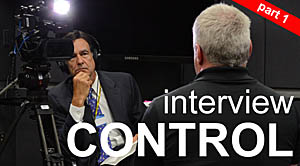


Claim Control Over Your Media Interview – Part 1
By Howard Fencl, Hennes Communications
Uh-oh. You’re plummeting down a rabbit hole. You agreed to give a reporter an interview. You know your topic inside and out. How tough can it be answering a few questions? But the reporter’s line of questioning is coming at you fast and starting to feel…uncomfortable. You stammer over an answer. You start feeling that Nixon-debate patina of sweat trickling down the back of your neck. As the questions get uglier, you’re tossing off answers you wish you could take back.
Reporters are paid to control interviews. They’re paid to ask impertinent questions. Some relish it. And some love nothing better than to leap at you from out of nowhere, camera lights blazing and video rolling, to get the ambush interview their competitors would give their eyeteeth to score, particularly during a Nielsen sweeps rating period (the big money sweeps hit in February, May, July and October).
If you go into an interview unprepared – no matter how many times you’ve done interviews – the odds that you’ll crash and burn increase exponentially.
- Interviews are a very different animal than the kind of conversation we all experience every day. With interviews, be certain you are armed with key messages. Messages are the “takeaway” for your key audiences. They should be short and they should sound like a TV soundbite. Have no more than two or three messages. Why so few? Because it’s impossible for people to digest a deluge of information at one time.
- Repeat messages often throughout an interview. This maximizes your chances that the reporter will select one of your messages as a soundbite to edit into their story. It does feel counterintuitive to repeat yourself over and over in an interview, but remember, this is not a conversation. The reporter is editing a story and will only use one or two of your quotes – they won’t use the entire interview. Make sure the quote they use is one of your key messages by using them early and often throughout the interview.
- Get in the reporter’s head and brainstorm all the tough questions you anticipate you might get. When you anticipate the tough questions, the quality of your answers will always improve. This isn’t just true for a media interview – try this the next time you do a presentation that you know will be followed by a Q&A. You’ll be happy you did.
Once you’ve answered the tough stuff, it’s important you take control of the interview back again. You can do that by using a pivot phrase to help you circle back to one of your key messages. For example, once you’ve answered a question, try saying “Here’s the important thing to remember.” Then deliver a message. Or use a pivot phrase as simple as “let me repeat,” followed by a message.
How does that win control? It sets context for the reporter. In our next installment of Crisis Management Today, I’ll talk about why that’s so important, and I’ll share a few more tactics to help tame an ambush interview, and to tip the control scale in your favor during an interview.